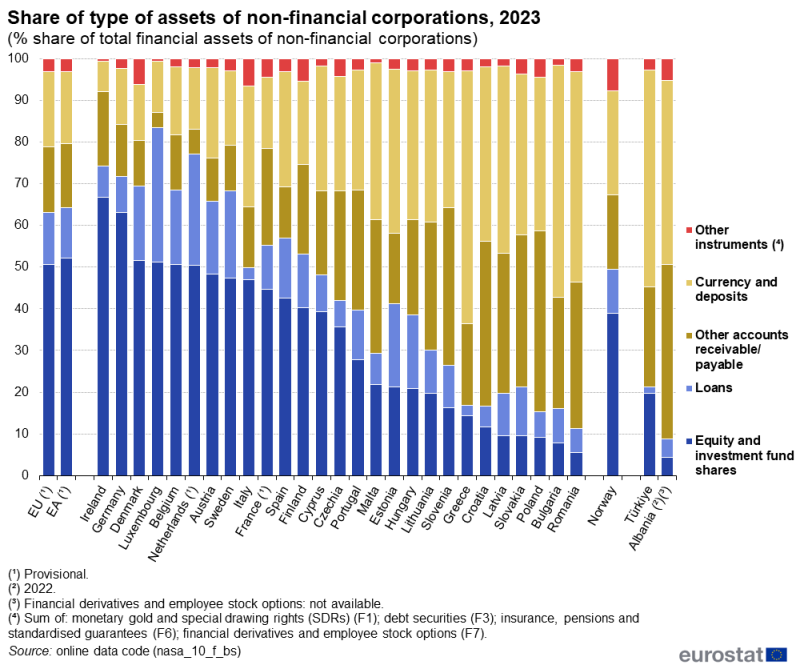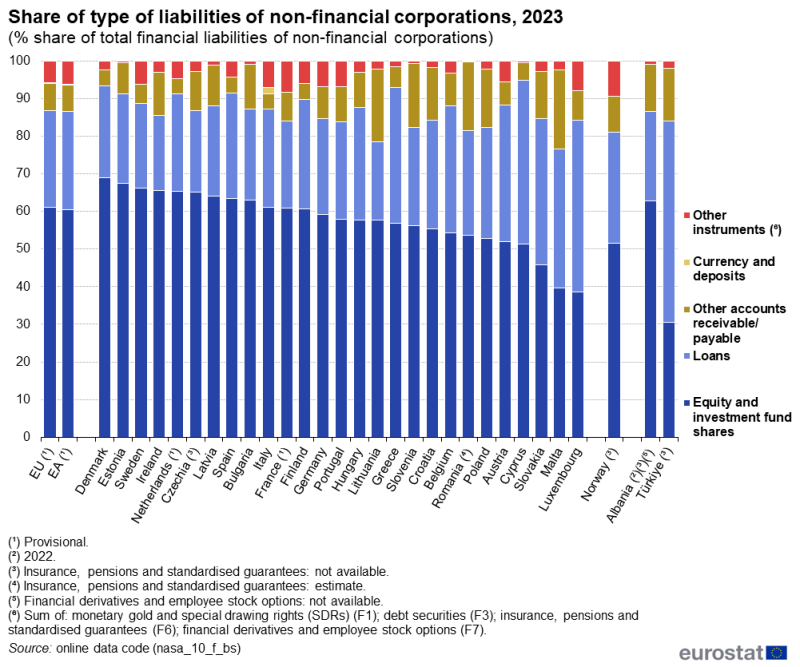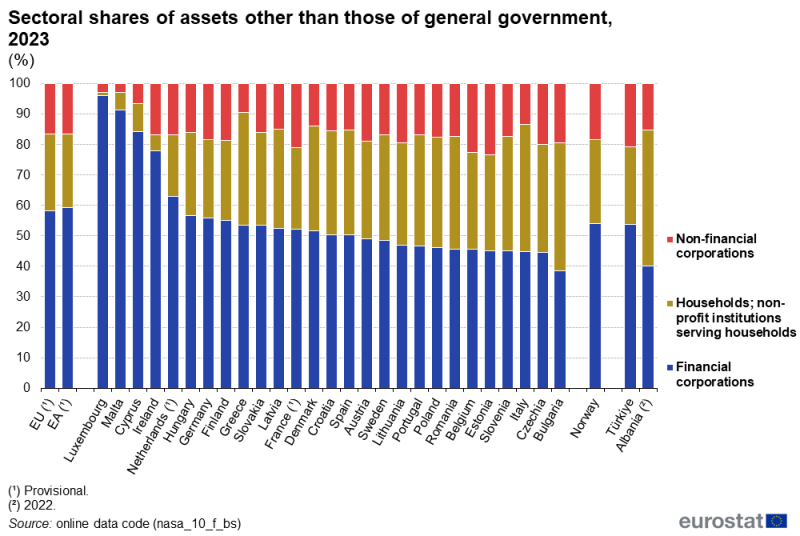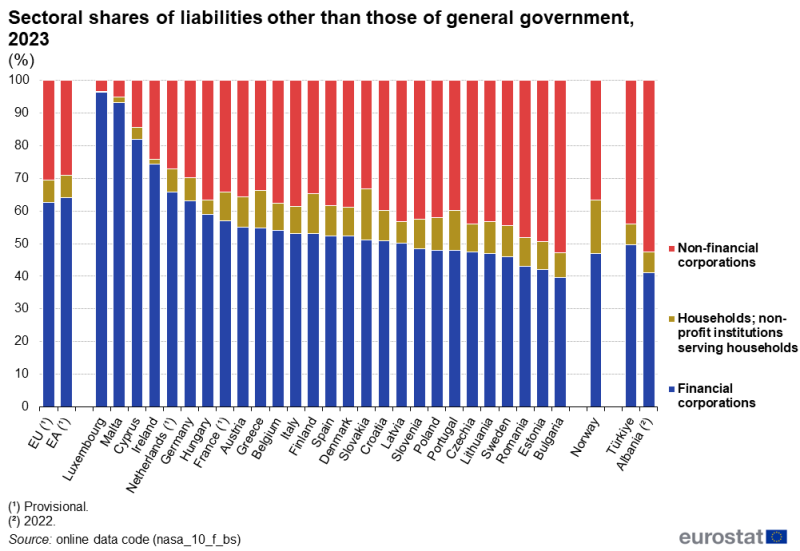Data extracted on 28 October 2024.
Planned article update: October 2025.
Highlights
Collectively, 4 EU countries – Germany, France, the Netherlands and Italy – accounted for a majority of the financial assets (66.4%) and liabilities (60.3%) of the EU's non-financial corporations in 2023.
Equity and investment fund shares accounted for the largest share of financial assets (50.7%) and liabilities (61.0%) of the EU's non-financial corporations in 2023.

(%, change over previous year)
Source: Eurostat (nasa_10_f_bs)
This article focuses on the annual stock of financial assets and liabilities for non-financial corporations. Note that there are complementary articles that provide similar information on financial corporations and households. The present article also includes a comparison between these sectors.
The non-financial corporations sector comprises all private and public corporate enterprises that produce goods or provide non-financial services to the market.
Across the European Union (EU), the financial assets of non-financial corporations mainly comprise equity and investment fund shares, loans, other accounts receivable, and currency and deposits. The financial liabilities of non-financial corporations mainly comprise equity and investment fund shares, loans and other accounts payable.
The data presented in this article relate to a detailed set of non-consolidated financial balance sheets for the non-financial corporations sector, as released by Eurostat. Note that statistics detailing the financial accounts may be consolidated or non-consolidated; the latter record not only transactions and positions between sectors (non-financial corporations with other actors in the economy) but also transactions and positions within the same sector (between non-financial corporations).
This article provides an analysis of financial assets and liabilities in the EU and the euro area (EA), as well as for individual EU countries, 1 of the EFTA countries (Norway) and 2 of the enlargement countries (Albania and Türkiye). Data are generally available for 2023; the latest data available for the euro area and Albania are for 2022. Some indicators are presented in relation to gross domestic product (GDP), which is beneficial for making cross-country comparisons, especially between countries of different size.
Assets and liabilities
Germany, France, the Netherlands and Italy collectively accounted for 66.4% of financial assets and 60.3% of liabilities of the EU's non-financial corporations in 2023
Total financial assets of the EU's non-financial corporations were valued at €24 208 billion in 2023. This was much lower than the value of their financial liabilities which stood at €41 751 billion. Combined, these values resulted in a larger negative net asset position in 2023 (€17 544 billion) than in 2022 (€16 509 billion).
The annual rate of change for total financial assets and liabilities of non-financial corporations between 2022 and 2023 is illustrated in Figure 1. The EU recorded growth of 2.0% for assets and a decline of 3.7% for liabilities.
It should be noted that rates of change are calculated in national currencies. Among the EU countries, the highest annual growth rates for assets were observed in Lithuania (26.4%), Czechia (22.5%), Romania (17.1%) and Croatia (11.2%). For liabilities, Czechia (12.7%) and Greece (12.4%) had the highest annual growth rates, followed by Lithuania (11.7%). Among the non-EU countries shown in Figure 1, Türkiye had much higher rates (63.6% for assets and 55.3% for liabilities). A total of 7 EU countries recorded negative annual rates of change for assets, the largest being a fall of 7.4% in the Netherlands. Among the 5 EU countries which had negative rates of change for liabilities, the largest decrease was 4.6% in Finland. A total of 13 EU countries had faster growth for assets than for liabilities, with the largest differences in the 2 rates observed in Lithuania (14.7 percentage points (points)), Romania (10.6 points) and Czechia (9.8 points). Among the 13 EU countries where the growth rate was faster for liabilities than for assets, the largest differences were in Sweden (9.7 points), Greece (8.8 points) and Denmark (8.2 points).

(%, change over previous year)
Source: Eurostat (nasa_10_f_bs)
The share of each EU country in the EU's total financial assets and liabilities of non-financial corporations in 2023 is presented in Figure 2. Germany held more than a quarter of the financial assets (26.0%) of non-financial corporations in the EU as well as more than a fifth of the liabilities (21.2%). France had more than a fifth of assets (22.4%) and a smaller share of liabilities (19.8%). The Netherlands held just over a tenth of assets (10.7%) and just under a tenth of liabilities (9.5%), while Italy had a smaller share of assets (7.4%) compared with its share of liabilities (9.7%). Aside from Ireland and Spain, all of the other EU countries held shares that were less than 6.0% (for either assets or liabilities). Germany, France, the Netherlands and Italy collectively accounted for 66.4% of financial assets and 60.3% of liabilities of the EU's non-financial corporations.

(%)
Source: Eurostat (nasa_10_f_bs)
Figure 3 presents the financial assets and liabilities of non-financial corporations as a percentage of GDP. In 2023, these assets were valued in the EU at 140.8% of GDP, while these liabilities were valued at 242.8% of GDP, resulting in negative net assets equivalent to 102.0% of GDP. In relative terms, the financial liabilities of the EU’s non-financial corporations were 1.7 times as high as their assets.
Net assets of non-financial corporations were negative (in other words, liabilities were greater than assets) in 2023 for all EU countries. Negative net assets ranged from 259.3% of GDP in Denmark and 259.0% in Sweden to 54.8% of GDP in Slovakia. Comparing the ratio of financial liabilities with that for assets, the largest relative difference was in Greece, where non-financial corporations' financial liabilities were 3.8 times as high as assets. The smallest difference was recorded in Luxembourg, where liabilities were 1.2 times as high as assets.
In all EU countries, the value of non-financial corporations' financial liabilities as a percentage of GDP was above 100.0% in 2023; in other words, liabilities were greater than GDP. The ratio was highest in Luxembourg and in Ireland, where the financial liabilities of non-financial corporations were valued at, respectively, 5.1 and 4.8 times their GDP. As such, the value of their financial liabilities as a percentage of GDP was approximately double the EU average for this ratio.
By contrast, the value of non-financial corporations' financial assets was below 100.0% of GDP in 16 EU countries. Luxembourg and Ireland again recorded the highest ratios, as the financial assets of non-financial corporations were valued at, respectively, 4.3 and 3.2 times their GDP.

(%)
Source: Eurostat (nasa_10_f_bs)
Structure of assets and liabilities
There are 4 prominent types of instruments of assets and liabilities of non-financial corporations in the EU: currency and deposits; loans; equity and investment fund shares; other accounts receivable/payable. Small shares (at most 1.8% of assets or 4.5% of liabilities) of total financial assets/liabilities of EU non-financial corporations in 2023 were accounted for by 4 other types of assets and liabilities: monetary gold and special drawing rights (SDRs); debt securities; insurance, pensions and standardised guarantees; financial derivatives and employee stock options. In this article, these smaller types of instruments are grouped together as 'other instruments' in Figure 4 for assets and Figure 5 for liabilities. The category of monetary gold and special drawing rights (SDRs) was valued at zero for all EU countries for the non-financial corporations sector.
The largest shares of non-financial corporations' financial assets were equity and investment fund shares, and currency and deposits
The category of equity and investment fund shares accounted for the largest share (50.7%) of financial assets of EU non-financial corporations in 2023. This type of instrument was followed by currency and deposits (17.9%), other accounts receivable/payable (15.8%) and loans (12.5%). Other instruments accounted for a 3.2% share.
The largest type of assets held by non-financial corporations in 2023 varied somewhat among the EU countries.
- Equity and investment fund shares was the largest category for 14 EU countries as well as in Norway. Among these, there were 6 where this category contributed more than half of all financial assets: Ireland (66.7%), Germany (63.2%), Denmark (51.7%), Luxembourg (51.2%), Belgium (50.6%) and the Netherlands (50.5%).
- Currency and deposits was the largest category in 10 EU countries and joint largest in 1 more; this category was also the largest in Albania (2022 data) and Türkiye. In 3 of the 11 EU countries, currency and deposits contributed more than half of all financial assets: Greece (60.7%), Bulgaria (55.5%) and Romania (50.5%); this was also the case in Türkiye (52.0%).
- Other accounts receivable/payable was the largest category in Poland and Slovenia and joint largest in Portugal; the highest share among these was 43.3% in Poland.

(% share of total financial assets of non-financial corporations)
Source: Eurostat (nasa_10_f_bs)
Non-financial corporations' financial liabilities were mainly equity and investment fund shares; loans also made up a relatively large share
The largest shares of total financial liabilities of the EU's non-financial corporations in 2023 were equity and investment fund shares (61.0%) and loans (25.8%). Other accounts receivable/payable had a 7.2% share, followed by other instruments (5.8%); the latter was mainly in the form of debt securities (4.5% of the total). The share for currency and deposits was 0.2%.
A comparison of the structure of financial assets with that for financial liabilities of the EU's non-financial corporations in 2023 shows 4 main differences
- currency and deposits made up 17.9% of assets compared with 0.2% of liabilities
- loans made up 12.5% of assets compared with 25.8% of liabilities
- equity and investment fund shares made up 50.7% of assets compared with 61.0% of liabilities
- other accounts receivable/payable made up 15.8% of assets compared with 7.2% of liabilities.
Among the EU countries, the 3 largest types of liabilities held by non-financial corporations in 2023 were generally equity and investment fund shares, loans, and other accounts receivable/payable. Equity and investment fund shares was the largest category in all EU countries except for Luxembourg. This category accounted for half or more of financial liabilities in 24 EU countries, peaking at 68.8% in Denmark. In Luxembourg, loans accounted for 45.7% of liabilities, the largest share for any EU country; a larger share was recorded for Türkiye (53.4%). The largest share of financial liabilities of non-financial corporations held in other accounts receivable/payable was 21.0% in Malta, while other instruments accounted for less than a tenth of the total in all EU countries, peaking at 8.3% in France.

(% share of total financial liabilities of non-financial corporations)
Source: Eurostat (nasa_10_f_bs)
Developments
The value of financial assets of non-financial corporations as a percentage of GDP decreased in 2023 in 22 EU countries
In absolute terms, total financial assets of the EU's non-financial corporations increased continuously during the period 2013–23. By 2023, the total value had increased by 81.8%, from €13 312 billion in 2013 to €24 208 billion in 2023. A similar development over the same period was observed for total financial liabilities, but with decreases in 2018 (down 0.1%) and 2022 (down 1.6%). Overall, financial liabilities increased by 63.9% from €25 467 billion in 2013 to €41 751 billion in 2023.
Despite an absolute increase in the value of financial assets of non-financial corporations in 2023, this value as a percentage of GDP was 6.2 points lower in 2023 than in 2022 in the EU (see Figure 6); a relative decrease of 4.2%. This ratio increased in 4 EU countries, up 15.4% in Lithuania, 13.2% in Czechia, 1.6% in Estonia and 1.5% in Romania. Norway also recorded a relatively large increase in 2023, up 15.4%. There was no change in this ratio in Italy. Elsewhere, the decrease was largest in the Netherlands (down 13.8%), followed by Hungary (down 11.5%), Malta (down 9.0%) and Belgium (down 8.6%).

(%)
Source: Eurostat (nasa_10_f_bs)
Comparison between sectors
Non-financial corporations held a higher share of financial liabilities; households and NPISH held a higher share of financial assets
A comparison of the relative size of financial assets and financial liabilities for various sectors gives valuable insights. Figure 7 for assets and Figure 8 for liabilities compare 3 sectors – financial corporations, non-financial corporations, and (combined) households and non-profit institutions serving households (NPISH). Note that the general government sector isn't included in this comparison and so the analyses refer only to a part of the domestic economy.
In the EU, the financial corporations sector held the largest share of financial assets (58.4%) and liabilities (62.5%) in 2023. Non-financial corporations had the 2nd largest share of liabilities (30.5%) but the smallest share of assets (16.4%), while households and NPISH had the 2nd highest share of assets (25.2%) but the smallest share of liabilities (7.1%).
In the EU, the value of financial assets held by financial corporations in 2023 was 3.6 times that held by non-financial corporations. In most EU countries, the value of financial assets of financial corporations was between 1.9 and 5.8 times as high as that of non-financial corporations, with higher ratios in Cyprus (12.8 times), Malta (33.6 times) and Luxembourg (33.7 times).

(%)
Source: Eurostat (nasa_10_f_bs)

(%)
Source: Eurostat (nasa_10_f_bs)
Source data for tables and graphs
Data sources
The compilation of financial accounts follows the European System of Accounts 2010 (ESA 2010).
Following recommendations for a harmonised European revision policy for national accounts and balance of payments, EU countries have carried out a benchmark revision of their national accounts estimates in 2024. The purpose of this benchmark revision was to implement changes introduced by the amended ESA 2010 regulation, and to incorporate new data sources and other methodological improvements. Most of the revised quarterly and annual country data have been released by Eurostat between June and October 2024, and progressively integrated in estimates for the EU and the euro area. For further details, please consult the available documentation on Eurostat's website.
In the October 2024 version of this article, the results of the benchmark revisions on financial accounts are included.
The financial account and balance sheet
Eurostat's website includes detailed financial accounts by country. Financial accounts are published in consolidated and non-consolidated forms; within this article the latter are presented. As a rule, the accounting entries in ESA 2010 are non-consolidated, as a consolidated financial account requires information on the counterpart grouping of institutional units. Note that data for the EU and EA aggregates are calculated as a sum of data for EU and EA countries; no adjustment is made for flows between countries.
The non-financial corporations sector
In general, sole proprietorships and most partnerships that don't have an independent legal status are considered to be part of the household sector, rather than as corporations (financial or non-financial). However, there are sometimes practical difficulties in delineating 'quasi-corporations' (unincorporated businesses with the characteristics of companies) between corporations on one hand and the household sector on the other, which may influence the scope and comparability of the data presented as well as the internal consistency of the full set of accounts.
Context
Financial accounts form part of the national accounting framework and are compiled in the EU in accordance with ESA 2010. They are a significant tool for analysing financial developments and policy decisions, and provide key statistical information on financial transactions, other financial flows and financial balance sheets by institutional sector, including non-financial corporations. Particular issues relating to the non-financial corporations sector include the indebtedness of the sector, its debt servicing burden and its impact on access to external finance as well as its capacity to withstand economic shocks. Since the global financial and economic crisis financial accounts for non-financial corporations have been integrated into an enlarged set of policy indicators – the EU's macroeconomic imbalance procedure (MIP) surveillance mechanism – that are used to identify potential macroeconomic risks early on, prevent the emergence of harmful macroeconomic imbalances and correct the imbalances that are already in place.
Financial accounts show how borrowers obtain resources by incurring liabilities or reducing assets, and how lenders allocate their surpluses by acquiring assets or reducing liabilities. The types of assets and liabilities that non-financial corporations hold carry different levels of risk and can be used to assess financial risk, vulnerability and welfare.
Explore further
Other articles
Database
- Financial flows and stocks (nasa_10_f)
- Financial balance sheets - annual data (nasa_10_f_bs)
